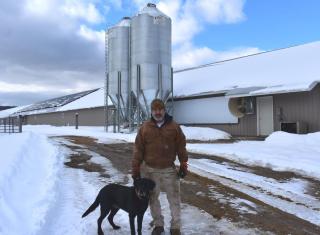Boscawen Egg Farm Goes Solar

The Union Leader published an article on March 31, 2019 about Town of Boscawen resident Tom Giovagnoli. The article is below:
BOSCAWEN — An egg farmer here is the newest poster child for harnessing the power of the sun, which, despite a tariff and a second consecutive year of a decline in the number of New Hampshire workers in the solar energy industry, is poised for significant growth in 2019.
In February, the Solar Foundation released its National Solar Jobs Census 2018. The report said New Hampshire lost 261 jobs in the solar energy industry last year, which represented a 15 percent decline and reflected a national trend in which the solar industry shrank by 3.2 percent or 8,000 jobs.
Uncertainty involving China and the manufacture of solar panels as well as state policy and economic challenges were cited in the report as factors in the declines.
But, as Tom Giovagnoli discovered, there are still many good reasons for going solar, not the least of which are the financial incentives to convert; dropping equipment costs; the fact that the price of electricity is not coming down anytime soon; and, in the New Hampshire Legislature, an increased appreciation of renewable energy.
Just before Jan. 1, Giovagnoli’s 200-acre egg farm went live with its solar array, which provides all the power needed to both heat and cool the 588-by-46-foot barn that is home to 20,000 hens that lay eggs for Monroe-based Pete & Gerry’s Organic Eggs.
Where Giovagnoli had previously been paying about $1,000 a month for electricity, his post-solar cost is around $100.
A 1982 graduate of Manchester’s Memorial High School, Giovagnoli, 55, grew up with farming in his blood. His parents, the late John and Laurette Giovagnoli, not only raised ten children – “I was No. 9,” Giovagnoli said – but also kept dairy and cattle cows for their own use while producing hogs commercially.
With help from his three sons, the former diesel-engine mechanic for the city of Manchester had his own farm in Dunbarton.
But when Giovagnoli neared retirement from his day job in 2014 and contemplated becoming a contractual egg producer for Pete and Gerry’s, he found that Dunbarton was not as open as he hoped to the venture but later found a more receptive welcome in Boscawen.
Drawing on both his farming and mechanical backgrounds, Giovagnoli concluded that the biggest expense his new farm, which opened in 2016, would face is “keeping the hens cool,” ideally, right around, 70 degrees.
Giovagnoli watched with dismay as his electricity bill climbed from between $400 to $500 a month to double that amount. It was then he decided to go solar.
After speaking with several other companies, he contacted ReVision Energy, a solar developer and contractor that serves Maine, New Hampshire and Massachusetts and that has five offices, including in Brentwood and Enfield.
Through grants and the federal 30 percent investment tax credit, which is cycling down as of 2019, Giovagnoli was able to cover 40 percent of the cost of his $100,000 solar array.
Because he also put in some of his own money, Giovagnoli expects to pay off the solar project within as few as three years, whereas the solar panels and string converters that ReVision installed have a rated life of 25 years and probably as many as 40.
Given his experience, Giovagnoli is already considering building a second, solar-powered hen barn.
Elijah Garrison, who is director of commercial sales for ReVision and had also worked on the residential side of the business, said ReVision may have “more demand than we can possibly install this year.”
“You’re talking to a sales guy,” he said during a recent interview, “but, literally, there’s never been a better time to go solar than in 2019.”
Asked about tariffs and equipment costs, Garrison said the international solar industry, as cited in a Jan. 5 article by the Motley Fool, went through a period of extremely high demand in 2017 that drove the price of solar panels way up.
But when the U.S. imposed tariffs last year and China cut its internal incentives on production, the price of solar panels fell and the industry is now faced with an oversupply of them.
That oversupply is good for consumers, be they residential or commercial, said Garrison.
“The big-picture view is that solar is a long-term investment that marries up the opportunity to reduce energy costs, reduce reliance on fossil fuels and produce energy locally.”
Solar, Garrison said, “provides energy to the regional power grid at the time when the energy is most valuable – during the peak of summer – and if you look at ISO-New England, that’s when it’s the most expensive.”
While the federal investment tax credit is winding down, it will still be around for a while, said Garrison. Beginning in 2020, the tax credit will drop from 30 to 26 percent of the total cost for a residential or commercial project, he said, and then to 22 percent in 2021.
The tax credit will eventually go to zero for residential applications but will not go below 10 percent for commercial ones.
The latter also provides for a one-time accelerated depreciation bonus, which Garrison said is typically about 20 percent of the project cost.

